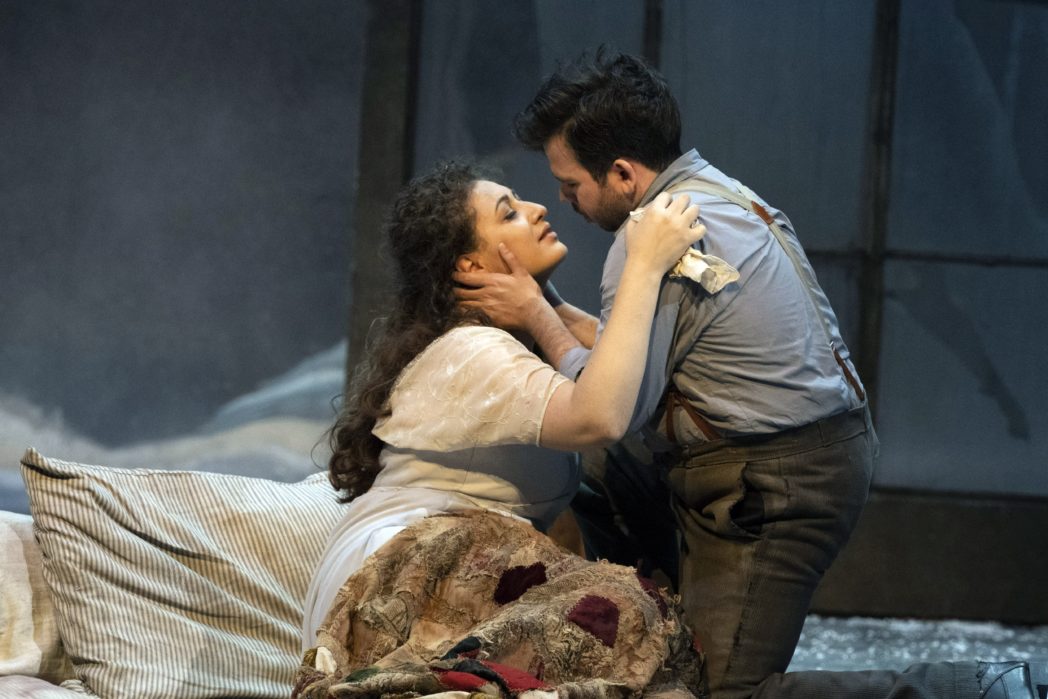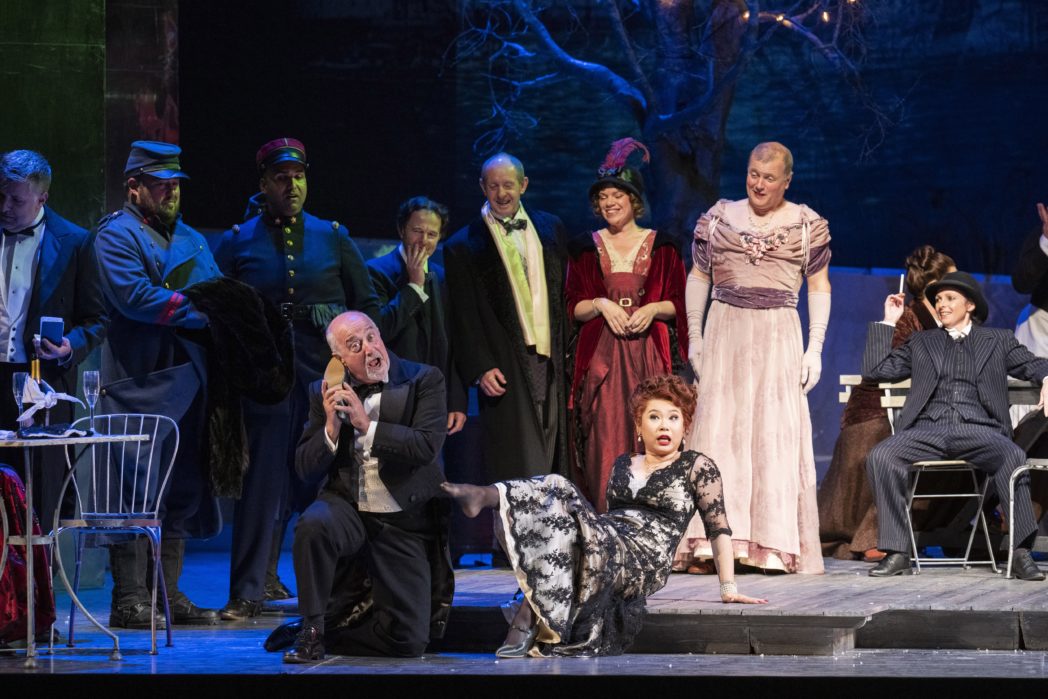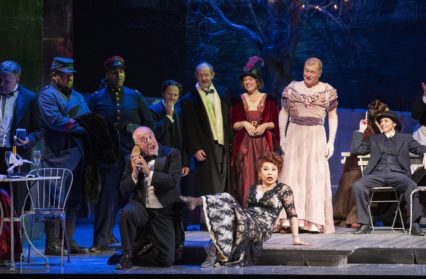Whatever one’s view of first outings, WNO always does its revivals well. A production of Puccini’s La bohème, first seen ten years ago, is another fine addition to the company’s Autumn season. Nigel Jarrett was at the opening.
Annabel Arden’s brightly detailed production of La bohème, premièred by WNO in 2012, has lost nothing in its revival under director Caroline Chaney. Puccini set the opera in the final decades of the 19th century; Arden shunted it forwards to the years before the First World War at a time when temporal shifts were potentially seismic. Maybe our recent and most vivid reminder that war has consequences beyond the battlefields now makes war’s imminence – Franco-Prussian or ‘Great’ – the thundercloud that looms above the opera’s uneasy mixture of jollity and misery. One is persuaded to imagine that when the populous act two freeze-frames for a couple of seconds and birds take flight in Nina Dunn’s video back-projection there’s a sense of portent. And when the bohemian lads depart at the end, leaving Mimi’s body on stage, it’s likely that, as cannon-fodder, they’ll never return.

A classic La bohème, then, with interesting, not to say disturbing, overtones and under-currents. It’s just as well that they can be added to an opera that ultimately centres on the death of a famished woman and encourages the audience to reach for its Kleenexes. Stephen Brimson Lewis’s designs are just so, Tim Mitchell’s lighting illuminates places where there’s not much light except what people create among themselves, and Philippe Giraudeau’s choreography further enlivens already animated scenes, not least the comings and goings at Café Momus in act two. The detail here is prodigious and possibly arcane: for example, at the table with all the others in a Wagamama setting are simulacra of Gertrude Stein and Alice B. Toklas and a collage of social types, indicating how the bohemian life is not predicated just on penury and disappointment.
The café scene involves a children’s ensemble as well as the WNO chorus, both well-drilled as ever, and a new Parpignol in Huw Llywelyn, replacing chorus member Michael Clifton-Thompson, who swops the ape outfit for evening wear at the café table – al fresco, which still seems odd on the same Christmas Eve that not an hour before found the bohemians freezing in the garret. Its musical centre is the waltz song of Musetta, sung with not too much flamboyance by Haegee Lee as her sugar daddy Alcindoro (Martin Lloyd) waits for his discomfiture to end. Musetta straddles the scene’s mélange of class and proclivity, ending up in act three’s custom-post bar in the arms of bohemian Marcello, sung ardently and evenly throughout by Rodion Pogossov. In terms of this production’s antebellum setting, it’s not so much a customs post as a barricade – or soon will be. This scene arguably has the best music of the opera, as its sentiments are not just melting but at odds.
Armenian soprano Anush Hovhannisyan, a finalist in the 2017 Cardiff Singer of the World competition, allows Mimi to assume the rarely achieved state of being able to express the passion that deprivation and the jealousy of her lover Rodolfo have crushed. Respectively, it balloons forth from her great act one aria and convulses her in the act three exchanges. Luis Gomes invests Rodolfo with a more mercurial vocal line which nevertheless contributes to a character who always seems no better than he ought to be. But Mimi has no time for jealousy: she’s desperate, besotted, romantically wretched and finally at death’s door, in that order. Rodolfo and his pals – Marcello, Schaunard (Benson Wilson), and Colline (David Shipley) make a lively bunch, confident enough to see off the hapless landlord Benoit (Howard Kirk).

Conductor Pietro Rizzo’s tempi don’t hang about and there are places where a more reflective approach might have been in order. The first part of act three, however, a conductor’s challenge like the central act of Tosca, was meticulously delineated. Puccini, the supreme manipulator of audience reaction, doesn’t stint in those instances where it has to stop swooning and consider brute realities. Despite the quick passages, the WNO orchestra responded as directed, though having played this love-and-death stuff many times before must have an acute feeling for what’s a tad askew and what isn’t.
It’s another fine addition to WNO’s autumn season, already launched by Olivia Fuchs’s new production of Janáček’s The Makropulos Case, also reviewed here.
Nigel Jarrett is a winner of the Rhys Davies Prize and the Templar Shorts Award, both for short fiction. His sixth book, a fictional memoir, is Notes From the Superhorse Stable. It appeared this year from Saron Publishers. His fourth story collection, Five Go to Switzerland, will be published this autumn by Cockatrice Books. Jarrett, a former daily-newspaperman, is now a freelance arts critic and writes for Wales Arts Review, Acumen poetry magazine, Jazz Journal and several others. He lives in Monmouthshire and he swims a lot.



 Enjoyed this article? Support our writers directly by buying them a coffee and clicking this link.
Enjoyed this article? Support our writers directly by buying them a coffee and clicking this link.







